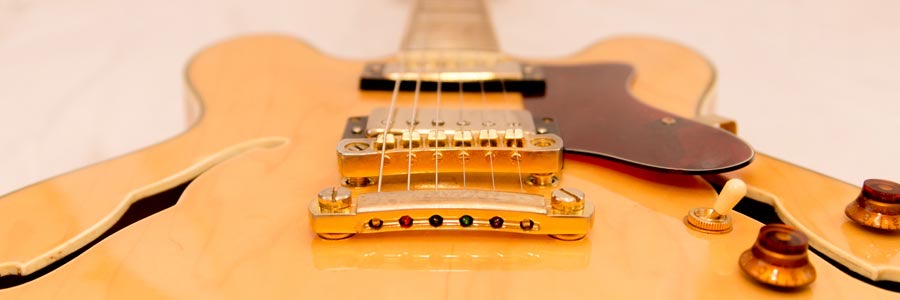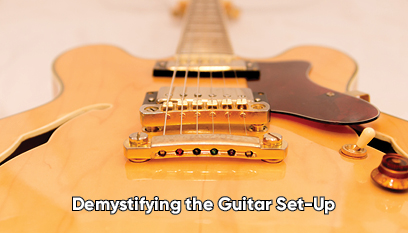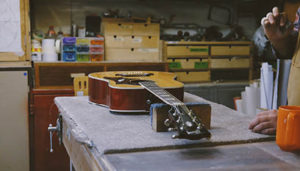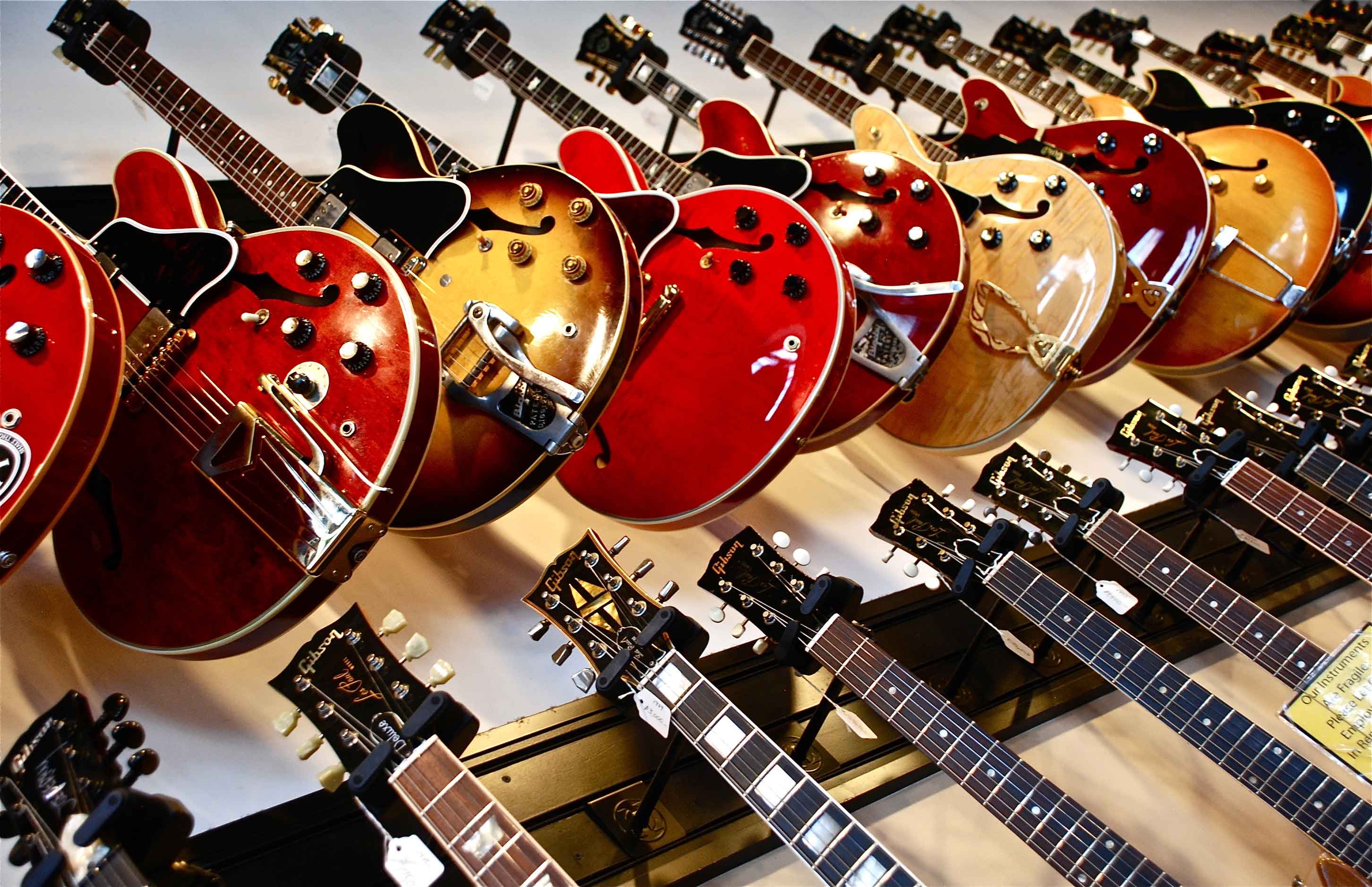
I played guitar for
years before I knew anything about guitar set-ups! I figured that guitars didn’t need much maintenance, other than changing the strings from time to time. The first time I got a guitar set-up was when I got my first nice guitar. I wasn’t even sure what I was supposed to ask for.
So does a guitar set-up involve, exactly? As part of a set-up, a luthier or guitar tech will adjust the action, check the intonation, and carefully inspect the guitar to see if any additional work is needed. Set-ups usually involve re-stringing and cleaning as well. A set-up will cost you in the ballpark of $50 and it’s well worth it.
I remember walking into the local shop that was known for honest repair work and asking for a set-up. I prayed there were no follow-up questions so I wouldn’t have to admit my ignorance. But the follow-up question I got made my day: “No problem. Do you need it done by the weekend for a gig?” He thought I had a gig! “No gig this weekend. Take your time,” I was able to honestly answer while maintaining the guise of being a gigging musician — kind of.
When I came back to retrieve the guitar, it played like a dream. I was so happy that I confessed that I hadn’t been sure what I was even asking for, and they happily explained what they had done.
Thank you to Scott Miller of Stonewall Guitars for his help with this post. Scott builds and repairs guitars and makes custom boutique pickups for electrics. He is a graduate of Roberto-Venn School of Luthery in Phoenix, Arizona and lives here in New Hampshire.
What is Usually Included in a Guitar Set-Up
1) Making sure the action is right.
The
action refers to the height of the strings off the fretboard. If the action is too high, the guitar can be frustrating and painful to play. If it’s too low, you can get buzzing and snagging.
Were you expecting an actual measurement for the correct action? There’s actually no universal standard on this. Experienced guitarists have a preference for how high they want their action to be, and it could vary from guitar to guitar. Beginners are better off with the action fairly low, because physically pressing down on the strings will be easier and new players usually have to build up their finger strength.
A set-up usually involves restringing, although you may have to buy the strings separately and bring them.
2) Making sure the intonation is right.
You might think your guitar is in tune because, well, you tuned it. (What, you don’t have a tuner?! Head over to my
list of the best tuners and fix that.) But if the intonation is off, the notes further up the neck will be off. A guitar tech can adjust the intonation at the bridge to make sure your guitar sounds great at every fret.
The length between the nut (where the headstock meets the fretboard) and the point on the bridge where the string makes contact with the guitar is set to a specific length. This length, as well as the tension on the string and its width (gauge), is what makes your A-string an A. When you make a chord shape, or fret a note, you have changed the length of the strings you are using, which changes the length of the string that is available to vibrate. This gives you new notes.
Most players tune their guitars by making sure that the open strings ring to their intended frequencies. When the guitar is properly intonated, notes that you fret will
also be in tune.
Guitars can lose their intonation for a variety of reasons. Most commonly, these reasons are due to changes in the weather, accidental damage, or issues with the bridge.
3) Giving the guitar a once-over to confirm that it’s in good working order.
The set-up will include tightening whatever knobs and nuts need it. If any repairs are needed, the guitar tech will make recommendations. A good luthier will alert you to a potentially major issue like warping before it gets worse.
4) Cleaning and polishing.
Your guitar will likely come back from a set-up shining like a detailed car. As a matter of pride, most techs will return your instrument to you not only playing better than when you brought it in, but also looking better.
What Isn’t Included in a Set-Up
A set-up does NOT include fixing bigger issues or replacing anything more significant than strings. For example, it won’t include a fret dress, new frets, or new pickups.
When Should You Get a Set-Up for Your Guitar?
If you just purchased the guitar, you should get a set-up. You’d think that a brand-new guitar would be perfect and ready to play, but temperature and humidity changes during transit can throw the factory set-up out of whack. The default settings are often terrible anyway.
For Scott Miller,
any brand-new guitar needs a set-up. “Every guitar right from the factory is going to need a set-up at the very least,” he said. “A factory set-up is just… almost nothing. Just to make sure the guitar plays buzz-free, which means the action is ridiculously high.”
Some of Scott’s regular customers bring in guitars as soon as soon as they buy them. These customers may just get a set-up and a fret dress, but sometimes they want a major overhaul. The factory settings leave a lot to be desired. “It’s like replacing the engine in a brand-new car,” he said. “But these cars don’t drive right.”
With a used guitar (such as a
yard sale guitar), a set-up is a way of resetting the whole instrument so it is ready for its new owner. You might want heavier strings, or higher action… whatever makes the guitar comfortable for YOU to play.
A guitar you play regularly should probably get a set-up twice a year, to account for humidity and temperature changes from season to season. (Granted, I live in New England, where the temperature can swing 110 degrees F over the course of the year.)
You should also consider a set-up if you are having specific issues (for example, you hear buzzing when you play certain notes, or you keep breaking strings in the same place), or the guitar has gotten less comfortable to play. Definitely let the luthier know if you are trying to
play guitar with arthritis or some other relevant medical condition, so they can find ways to make playing easier for you.
It helps to be as precise as you can. “I tell my customers that the more they understand their instruments, the easier it makes my job, because you can then tell me what’s wrong with your guitar more specifically than ‘This isn’t playing right,'” said Scott. “We can work together better and get your guitar the way it’s supposed to be.”
If you’re in doubt, bring your guitar in to a reputable luthier and see what they say. Professionals won’t just take your money for no reason.
Doing Your Own Set-Ups
Scott warned against doing your own set-up if you don’t know what you’re doing. Messing with the truss rod, for example, can cause permanent damage to the guitar. “People think that adjusting the truss rod is how you lower action,” he said. “So people will just tighten it all the way to lower the action, and it doesn’t do that. Neck relief is either right or it’s wrong. The
saddle is where you adjust the action.”
So don’t trust random YouTube videos to lead you in the right direction — take your guitar to a professional luthier for set-ups. This is especially true if your guitar has any complicated elements like a Floyd Rose.
Finding a Good Luthier
How do you go about finding a good luthier? It’s tricky, because there is no licensing or certification involved. Anyone can claim to be a luthier.
Scott suggested talking to local musicians. “You could go to an open mic night or see a band play, and ask them who they’re going to,” he said. Your
guitar teacher, if you have one, is another person who can point you to a reputable luthier in your area.
You can also go into a luthier’s shop and ask to see some of their work. A good luthier will have no problem showing you some of their recent projects. If they don’t respond well to this request, run for the hills!
Making the Most of Your Investment
After your guitar has been properly set-up is a great time to start taking better care of your instrument. It’s sort of like resolving to floss regularly right after getting your teeth cleaned.
The safest place for your guitar is in its case. This will protect it from accidental damage like falling out of a stand — which is likely to happen if you’re like me and have small children and a large dog running around. The case can also help protect your guitar from variations in temperature and humidity. But remember that most cases can only protect your guitar so much. If you then leave the case in an uninsulated attic over the winter or in a hot car for a week, you’ve likely undone quite a bit of the luthier’s work.
Winter can be a major problem due to the lack of humidity. “Basically, when you turn the heat on in the house, you want to start humidifying the guitar,” said Scott. That means storing the guitar in a humidity-controlled room, or keeping guitar in a case with a soundhole or a case humidifier. If you use a humidifier, make sure it’s never in the sun. The heat can turn the humidity into steam, which can cause glued joints to fail and cause a lot of problems.
I know many players enjoy having their guitars hung on the wall. While the feeling of having your trophies proudly on display is alluring, you shouldn’t do it routinely. Being hung on the wall is actually a big reason why new guitars need a set-up! Big box stores can sometimes have walls of guitars up to 25 feet tall. Usually the high-end instruments are up higher to protect them from teenagers and casual tire-kickers, but that also means they are further from the air conditioning. Next time you’re in an independent shop known for quality instruments, take note of where the really nice guitars are. I’ll bet the highest one isn’t more than 6 feet up.
Routine Maintenance You Can Do Yourself Between Set-Ups
Sweat and finger oils can take a their toll on the neck of your guitar — even if you’re not one of those sweaty-hands players. (You know, the ones who hand your guitar back to you and you immediately have to wipe it down.) It’s a great idea to keep a soft cloth like a bandana, a towel, or a cloth diaper (my personal favorite) in the case and give the guitar a quick rub down after every playing session.
String-changing time is the perfect time to give your guitar a little TLC. With the strings out of the way, you have access to the full fretboard and the frets. This allows you to use guitar-specific wood conditioner to clean and rehydrate the fretboard. These products will also help remove skin oil, which cause corrosion on the frets if allowed to build up. Scott recommends oiling a rosewood or ebony fretboard at least once a year to keep it in good shape.
One Last Tip
One last tip from our luthier friend:
Get rid of the silica gel packs that come in guitar cases! They suck up moisture from your guitar, and are not meant to stay in the case after purchase.
Related
 I played guitar for years before I knew anything about guitar set-ups! I figured that guitars didn’t need much maintenance, other than changing the strings from time to time. The first time I got a guitar set-up was when I got my first nice guitar. I wasn’t even sure what I was supposed to ask for.
So does a guitar set-up involve, exactly? As part of a set-up, a luthier or guitar tech will adjust the action, check the intonation, and carefully inspect the guitar to see if any additional work is needed. Set-ups usually involve re-stringing and cleaning as well. A set-up will cost you in the ballpark of $50 and it’s well worth it.
I remember walking into the local shop that was known for honest repair work and asking for a set-up. I prayed there were no follow-up questions so I wouldn’t have to admit my ignorance. But the follow-up question I got made my day: “No problem. Do you need it done by the weekend for a gig?” He thought I had a gig! “No gig this weekend. Take your time,” I was able to honestly answer while maintaining the guise of being a gigging musician — kind of.
When I came back to retrieve the guitar, it played like a dream. I was so happy that I confessed that I hadn’t been sure what I was even asking for, and they happily explained what they had done.
Thank you to Scott Miller of Stonewall Guitars for his help with this post. Scott builds and repairs guitars and makes custom boutique pickups for electrics. He is a graduate of Roberto-Venn School of Luthery in Phoenix, Arizona and lives here in New Hampshire.
I played guitar for years before I knew anything about guitar set-ups! I figured that guitars didn’t need much maintenance, other than changing the strings from time to time. The first time I got a guitar set-up was when I got my first nice guitar. I wasn’t even sure what I was supposed to ask for.
So does a guitar set-up involve, exactly? As part of a set-up, a luthier or guitar tech will adjust the action, check the intonation, and carefully inspect the guitar to see if any additional work is needed. Set-ups usually involve re-stringing and cleaning as well. A set-up will cost you in the ballpark of $50 and it’s well worth it.
I remember walking into the local shop that was known for honest repair work and asking for a set-up. I prayed there were no follow-up questions so I wouldn’t have to admit my ignorance. But the follow-up question I got made my day: “No problem. Do you need it done by the weekend for a gig?” He thought I had a gig! “No gig this weekend. Take your time,” I was able to honestly answer while maintaining the guise of being a gigging musician — kind of.
When I came back to retrieve the guitar, it played like a dream. I was so happy that I confessed that I hadn’t been sure what I was even asking for, and they happily explained what they had done.
Thank you to Scott Miller of Stonewall Guitars for his help with this post. Scott builds and repairs guitars and makes custom boutique pickups for electrics. He is a graduate of Roberto-Venn School of Luthery in Phoenix, Arizona and lives here in New Hampshire.

 I played guitar for years before I knew anything about guitar set-ups! I figured that guitars didn’t need much maintenance, other than changing the strings from time to time. The first time I got a guitar set-up was when I got my first nice guitar. I wasn’t even sure what I was supposed to ask for.
So does a guitar set-up involve, exactly? As part of a set-up, a luthier or guitar tech will adjust the action, check the intonation, and carefully inspect the guitar to see if any additional work is needed. Set-ups usually involve re-stringing and cleaning as well. A set-up will cost you in the ballpark of $50 and it’s well worth it.
I remember walking into the local shop that was known for honest repair work and asking for a set-up. I prayed there were no follow-up questions so I wouldn’t have to admit my ignorance. But the follow-up question I got made my day: “No problem. Do you need it done by the weekend for a gig?” He thought I had a gig! “No gig this weekend. Take your time,” I was able to honestly answer while maintaining the guise of being a gigging musician — kind of.
When I came back to retrieve the guitar, it played like a dream. I was so happy that I confessed that I hadn’t been sure what I was even asking for, and they happily explained what they had done.
Thank you to Scott Miller of Stonewall Guitars for his help with this post. Scott builds and repairs guitars and makes custom boutique pickups for electrics. He is a graduate of Roberto-Venn School of Luthery in Phoenix, Arizona and lives here in New Hampshire.
I played guitar for years before I knew anything about guitar set-ups! I figured that guitars didn’t need much maintenance, other than changing the strings from time to time. The first time I got a guitar set-up was when I got my first nice guitar. I wasn’t even sure what I was supposed to ask for.
So does a guitar set-up involve, exactly? As part of a set-up, a luthier or guitar tech will adjust the action, check the intonation, and carefully inspect the guitar to see if any additional work is needed. Set-ups usually involve re-stringing and cleaning as well. A set-up will cost you in the ballpark of $50 and it’s well worth it.
I remember walking into the local shop that was known for honest repair work and asking for a set-up. I prayed there were no follow-up questions so I wouldn’t have to admit my ignorance. But the follow-up question I got made my day: “No problem. Do you need it done by the weekend for a gig?” He thought I had a gig! “No gig this weekend. Take your time,” I was able to honestly answer while maintaining the guise of being a gigging musician — kind of.
When I came back to retrieve the guitar, it played like a dream. I was so happy that I confessed that I hadn’t been sure what I was even asking for, and they happily explained what they had done.
Thank you to Scott Miller of Stonewall Guitars for his help with this post. Scott builds and repairs guitars and makes custom boutique pickups for electrics. He is a graduate of Roberto-Venn School of Luthery in Phoenix, Arizona and lives here in New Hampshire.



